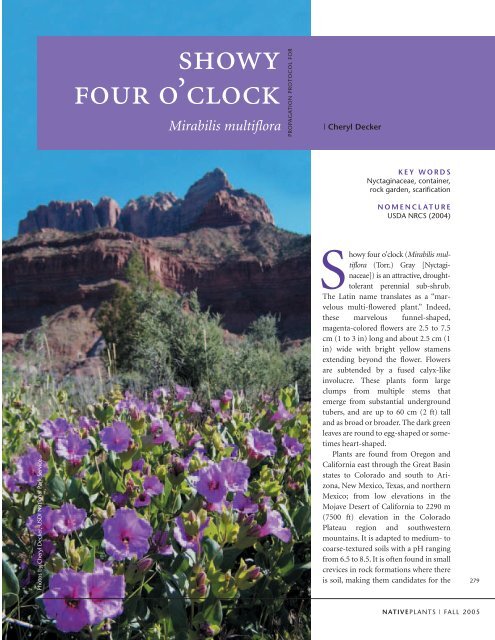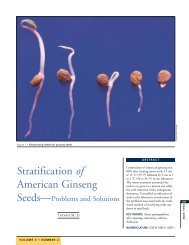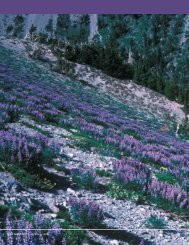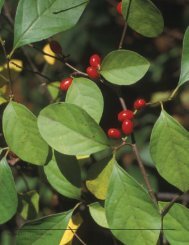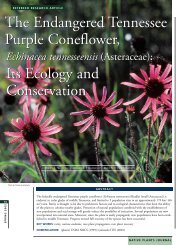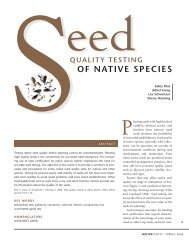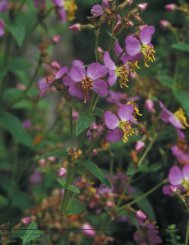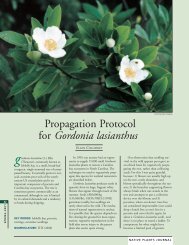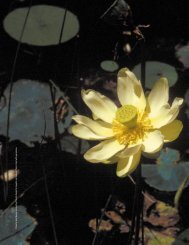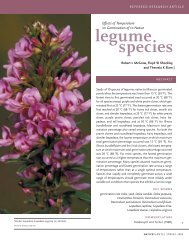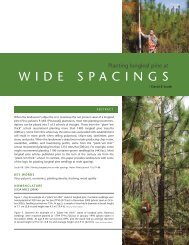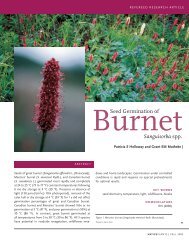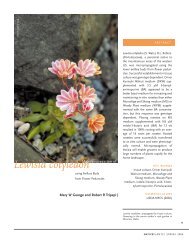Propagation Protocol for Showy Four O'Clock Mirabilis multiflora
Propagation Protocol for Showy Four O'Clock Mirabilis multiflora
Propagation Protocol for Showy Four O'Clock Mirabilis multiflora
You also want an ePaper? Increase the reach of your titles
YUMPU automatically turns print PDFs into web optimized ePapers that Google loves.
showy<br />
four o’clock<br />
<strong>Mirabilis</strong> <strong>multiflora</strong><br />
PROPAGATION PROTOCOL FOR<br />
| Cheryl Decker<br />
KEY WORDS<br />
Nyctaginaceae, container,<br />
rock garden, scarification<br />
NOMENCLATURE<br />
USDA NRCS (2004)<br />
Photos by Cheryl Decker, USDI National Park Service<br />
<strong>Showy</strong> four o’clock (<strong>Mirabilis</strong> <strong>multiflora</strong><br />
(Torr.) Gray [Nyctaginaceae])<br />
is an attractive, droughttolerant<br />
perennial sub-shrub.<br />
The Latin name translates as a “marvelous<br />
multi-flowered plant.” Indeed,<br />
these marvelous funnel-shaped,<br />
magenta-colored flowers are 2.5 to 7.5<br />
cm (1 to 3 in) long and about 2.5 cm (1<br />
in) wide with bright yellow stamens<br />
extending beyond the flower. Flowers<br />
are subtended by a fused calyx-like<br />
involucre. These plants <strong>for</strong>m large<br />
clumps from multiple stems that<br />
emerge from substantial underground<br />
tubers, and are up to 60 cm (2 ft) tall<br />
and as broad or broader. The dark green<br />
leaves are round to egg-shaped or sometimes<br />
heart-shaped.<br />
Plants are found from Oregon and<br />
Cali<strong>for</strong>nia east through the Great Basin<br />
states to Colorado and south to Arizona,<br />
New Mexico, Texas, and northern<br />
Mexico; from low elevations in the<br />
Mojave Desert of Cali<strong>for</strong>nia to 2290 m<br />
(7500 ft) elevation in the Colorado<br />
Plateau region and southwestern<br />
mountains. It is adapted to medium- to<br />
coarse-textured soils with a pH ranging<br />
from 6.5 to 8.5. It is often found in small<br />
crevices in rock <strong>for</strong>mations where there<br />
is soil, making them candidates <strong>for</strong> the<br />
279<br />
NATIVEPLANTS | FALL 2005
280<br />
xeric rock garden. Three botanical varieties<br />
are recognized: glandulosa<br />
(Standl.) J.F. Macbr. is found from Cali<strong>for</strong>nia<br />
east to Colorado and Arizona;<br />
<strong>multiflora</strong> is found throughout the<br />
range of the species; pubescens S. Wats. is<br />
found exclusively in Cali<strong>for</strong>nia.<br />
Like the species name suggests,<br />
plants can have multiple flowers covering<br />
the plant from April to September,<br />
especially after a rain. And<br />
as the common name indicates,<br />
four o’clocks bloom in the late<br />
afternoon and are open<br />
throughout the night. The<br />
flowers release a musky odor<br />
several hours after opening that<br />
attracts hawk moths [Lepidoptera: Sphingidae],<br />
the primary pollinator of these<br />
flowers. Following pollination, the lower<br />
portion of the floral tube becomes hardened<br />
and closely surrounds the indehiscent<br />
achene. The large seeds, as many as 4<br />
per flower, are dispersed when the papery<br />
involucre breaks apart. In southern Utah,<br />
the fruits are ready <strong>for</strong> collection in June<br />
and early July, and if heavy monsoon rains<br />
occur, again in September and October.<br />
Fruits are 6 to 11 mm (0.2 to 0.4 in) long<br />
containing a large, single, brown seed.<br />
At Zion National Park, seeds are handcollected<br />
when they are dark brown to<br />
black, ribbed, and very hard. Fruits are<br />
enclosed in a papery cup that can be carefully<br />
tipped into a collection bag to release<br />
the seed, which reduces the amount of<br />
chaff to remove later. We clean seeds by<br />
rubbing off any remaining flower parts<br />
and sifting out debris with a sieve. We<br />
have stored seeds in sealed containers at 4<br />
to 15 °C (40 to 60 °F) <strong>for</strong> up to 3 y with<br />
success. We typically see 9800 seeds/kg<br />
(4400/lb) with our seed source.<br />
Seeds require scarification and cold<br />
moist stratification <strong>for</strong> high rates of germination.<br />
We carefully crack the<br />
hard seed coats with a rubber mallet<br />
or with pliers, taking care not to<br />
damage the seeds. If the seed is<br />
longer than it is round, the end may<br />
simply be cut off with pruning<br />
shears. Seeds need approximately 1<br />
mo of cold moist stratification,<br />
which we provide naturally by sowing<br />
seeds in late winter and placing<br />
them in an outdoor nursery where<br />
they are subject to ambient weather.<br />
Seeds are sown in flats 10 cm (4 in)<br />
deep having drainage holes and<br />
filled with a medium of 1.5:1:1:2<br />
(v:v:v:v) vermiculite, sterile sand,<br />
coarse turface, and peat moss. Seeds are<br />
covered with a layer of vermiculite about<br />
as deep as the seed is thick. After stratification,<br />
flats may be brought inside the<br />
greenhouse to accelerate germination and<br />
lengthen the growing season. Germination<br />
begins within 1 wk of being exposed<br />
to warmer temperatures. Trays are watered<br />
thoroughly after sowing and are not<br />
allowed to dry out completely during germination.<br />
At the cotyledon stage, we transplant<br />
from the germination flats to 3.3-1 (1-gal)<br />
containers filled with the same medium<br />
used in the germination flats but also incorporated<br />
with Osmocote (13N:13P 2 O 5 :13K 2 O;<br />
8 to 9 mo release rate; The Scott’s Company,<br />
Marysville, Ohio) at the rate of 2 to 4<br />
kg (4.4 to 8.8 lb) per 0.76 m 3 (1 yd 3 ) of<br />
medium mix. It is important to transplant<br />
at the cotyledon stage because root growth<br />
is fast, and root de<strong>for</strong>mation will occur if<br />
delayed beyond this stage of development.<br />
Cotyledons are large and easy to handle<br />
without damaging the emerging root.<br />
We water seedlings by hand throughout<br />
the growing season. During the<br />
active growth phase, we irrigate when<br />
containers are nearly dry as a method of<br />
conditioning the plants while they are<br />
being grown. Watering can be tricky—<br />
showy four o’clock is a very droughttolerant<br />
plant and responds poorly to<br />
excess water. When grown in containers<br />
with a well-aerated medium, however,<br />
they cannot be allowed to dry out completely<br />
<strong>for</strong> more than half a day.<br />
When seeds are collected, treated, and<br />
sown in fall <strong>for</strong> natural winter stratification,<br />
we can grow plants to sufficient size<br />
in 3-1 (1-gal) containers in 10 mo. Storage<br />
tubers begin to <strong>for</strong>m almost immediately<br />
after seedlings are transplanted, and a firm<br />
root-ball will have <strong>for</strong>med by fall. Plants<br />
are precocious and may flower during the<br />
first growing season in the container.<br />
We typically outplant in the fall after<br />
daytime temperatures have cooled or<br />
fall rains have begun. Plants will quickly<br />
produce additional shoot growth once<br />
outplanted. We try to outplant all our<br />
stock because they do not overwinter<br />
well in pots unless kept fairly dry.<br />
NATIVEPLANTS | FALL 2005<br />
PROPAGATION PROTOCOL FOR SHOWY FOUR O’CLOCK
REFERENCE<br />
[USDA NRCS] USDA Natural Resources Conservation Service. 2004. The<br />
PLANTS database, version 3.5. URL: http://plants.usda.gov (accessed<br />
10 Jan 2005). Baton Rouge (LA): National Plant Data Center.<br />
ACKNOWLEDGMENT<br />
I am very grateful <strong>for</strong> the writing and editing assistance provided<br />
by Tara Luna.<br />
AUTHOR INFORMATION<br />
Cheryl Decker<br />
Native Plant Nursery Manager<br />
USDI National Park Service<br />
Zion National Park<br />
SR 9<br />
Springdale, UT 84767-1099<br />
Cheryl_Decker@nps.gov<br />
281<br />
NATIVEPLANTS | FALL 2005


